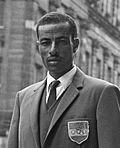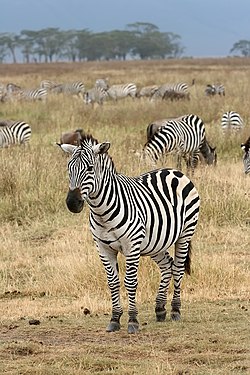
Back በር:ኢትዮጵያ Amharic بوابة:إثيوبيا Arabic Portal:Etiopía Spanish Portail:Éthiopie French Portal:Habsyah Malay Portal:Etiópia Portuguese Портал:Эфиопия Russian باب:ایتھوپیا Urdu
Introduction
Federal Democratic Republic of Ethiopia የኢትዮጵያ ፌደራላዊ ዴሞክራሲያዊ ሪፐብሊክ (Amharic) | |
|---|---|
| Anthem: [ወደፊት ገስግሺ ፣ ውድ እናት ኢትዮጵያ] Error: {{Lang}}: invalid parameter: |bold= (help) (English: "March Forward, Dear Mother Ethiopia") | |
 | |
| ISO 3166 code | ET |
Ethiopia, officially the Federal Democratic Republic of Ethiopia, is a landlocked country located in the Horn of Africa region of East Africa. It shares borders with Eritrea to the north, Djibouti to the northeast, Somalia to the east, Kenya to the south, South Sudan to the west, and Sudan to the northwest. Ethiopia covers a land area of 1,104,300 square kilometres (426,400 sq mi). As of 2024[update], it has around 132 million inhabitants, making it the tenth-most populous country in the world, the second-most populous in Africa after Nigeria, and the most populated landlocked country on Earth. The national capital and largest city, Addis Ababa, lies several kilometres west of the East African Rift that splits the country into the African and Somali tectonic plates.
Anatomically modern humans emerged from modern-day Ethiopia and set out for the Near East and elsewhere in the Middle Paleolithic period. In 980 BC, the Kingdom of D'mt extended its realm over Eritrea and the northern region of Ethiopia, while the Kingdom of Aksum maintained a unified civilization in the region for 900 years. Christianity was embraced by the kingdom in 330, and Islam arrived by the first Hijra in 615. After the collapse of Aksum in 960, the Zagwe dynasty ruled the north-central parts of Ethiopia until being overthrown by Yekuno Amlak in 1270, inaugurating the Ethiopian Empire and the Solomonic dynasty, claimed descent from the biblical Solomon and Queen of Sheba under their son Menelik I. By the 14th century, the empire had grown in prestige through territorial expansion and fighting against adjacent territories; most notably, the Ethiopian–Adal War (1529–1543) contributed to fragmentation of the empire, which ultimately fell under a decentralization known as Zemene Mesafint in the mid-18th century. Emperor Tewodros II ended Zemene Mesafint at the beginning of his reign in 1855, marking the reunification and modernization of Ethiopia. (Full article...)
Selected article -
The intercalary month or epagomenal days of the ancient Egyptian, Coptic, and Ethiopian calendars are a period of five days in common years and six days in leap years in addition to those calendars' 12 standard months, sometimes reckoned as their thirteenth month. They originated as a periodic measure to ensure that the heliacal rising of Sirius would occur in the 12th month of the Egyptian lunar calendar but became a regular feature of the civil calendar and its descendants. Coptic and Ethiopian leap days occur in the year preceding Julian and Gregorian leap years. (Full article...)
Selected biography -
Mikael Sehul (born Blatta Mikael; 1692 – 1784) was a nobleman who ruled Ethiopia for a period of 25 years as regent of a series of emperors. He was also a Ras or governor of Tigray 1748–71 and again from 1772 until his death. He was a major political figure during the reign of Emperor Iyasu II and his successors until almost the time of his death.
The Scottish explorer James Bruce met Mikael during his stay in Ethiopia, and recorded the following description of the Ras when he granted Bruce an audience:
(Full article...)"We went in, and saw the old man sitting upon a sofa; his white hair was dressed in many short curls. He appeared to be thoughtful, but not displeased; his face was lean, his eyes quick and vivid, but seemed to be a little sore from exposure to the weather. he seemed to be about six feet high, though his lameness made it difficult to guess with accuracy. His air was perfectly free from constraint, what the French call degagée. In face and person he was liker my learned and worthy friend, the Count de Buffon, than any two men I ever saw in the world. They must have been bad physiognomists that did not discern his capacity and understanding by his very countenance. Every look conveyed a sentiment with it: he seemed to have no occasion for other language, and indeed spoke little."
General images -
Related portals
Geography
Countries
WikiProjects
Main WikiProject
Related WikiProjects
Africa • Countries • Eritrea • African military history task force
Things you can do
- Visit the Ethiopian Wikipedians' notice board.
- The noticeboard is the central forum for information and discussion on editing related to Ethiopia.
- Comment at the Ethiopian deletion sorting page.
- This page lists deletion discussions on topics relating to Ethiopia
Selected pictures
Did you know -

- ... that Liberian paramount chief Tamba Taylor worked as a tailor and claimed to have sewn clothes for Ethiopian emperor Haile Selassie and Ghanaian president Kwame Nkrumah?
- ... that Quintin Johnstone advocated giving control of an American-governed law school to native Ethiopians?
- ... that Aguil Chut-Deng took 22 child refugees from South Sudan to Ethiopia during civil war so that they could attend school?
- ... that the government of Ethiopia's SNNP Region supported local governments calling for a referendum to secede from the region?
In the news
Categories
Topics
Other Ethiopia-connected Wikipedias
Wikimedia
The following Wikimedia Foundation sister projects provide more on this subject:
-
Commons
Free media repository -
Wikibooks
Free textbooks and manuals -
Wikidata
Free knowledge base -
Wikinews
Free-content news -
Wikiquote
Collection of quotations -
Wikisource
Free-content library -
Wikiversity
Free learning tools -
Wikivoyage
Free travel guide -
Wiktionary
Dictionary and thesaurus
Other portals







































































